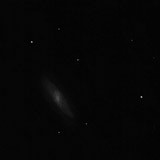
| MESSIER 106 |
|---|
RA: |
12h 19m 30s |
|
DEC: |
+47° 18' 00'' |
|
Type: |
Spiral galaxy |
|
NGC: |
4258 |
|
Magnitude: |
8.40 |
|
Surface brightness : |
13.60 |
|
Apparent dimensions : |
17.4'x6.6' |
|
Distance: |
25,000,000 ly |
|
M106 is one of Pierre Méchain's findings, which were later appended as additional objects to Charles Messier's catalog. In case of M106, it was Helen Sawyer Hogg who added it together with M105 and M107 in 1947, but it appears reasonable to assume that already Méchain had intended to add it to a future edition. William Herschel had numbered it H V.43 when cataloging it on March 9, 1788. The bright Sb spiral galaxy M106 is perhaps about 21 to 25 million light years distant. It is receding at 537 km/sec. Following the spiral arms in the sense of rotation, and most conspicuous on the right of our image, is the yellowish remnant of an older spiral arm. The color of this arm indicates that its more massive stars have ceased to shine long ago, the color of the remaining ones sums up to the yellow-greenish appearance. The age of the stellar population in this fossil spiral arm is estimated to several hundred million years. A supernova (1981K) occured im M106 in August 1981 and reached 16th magnitude. |
||
VEDRAN VRHOVAC© 2006.-2007. |
